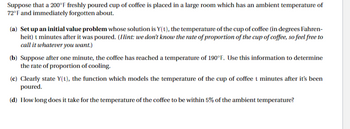
Advanced Engineering Mathematics
10th Edition
ISBN: 9780470458365
Author: Erwin Kreyszig
Publisher: Wiley, John & Sons, Incorporated
expand_more
expand_more
format_list_bulleted
Question

Transcribed Image Text:Suppose that a 200°F freshly poured cup of coffee is placed in a large room which has an ambient temperature of
72°F and immediately forgotten about.
(a) Set up an initial value problem whose solution is Y(t), the temperature of the cup of coffee (in degrees Fahren-
heit) t minutes after it was poured. (Hint: we don't know the rate of proportion of the cup of coffee, so feel free to
call it whatever you want.)
(b) Suppose after one minute, the coffee has reached a temperature of 190°F. Use this information to determine
the rate of proportion of cooling.
(c) Clearly state Y(t), the function which models the temperature of the cup of coffee t minutes after it's been
poured.
(d) How long does it take for the temperature of the coffee to be within 5% of the ambient temperature?
Expert Solution
This question has been solved!
Explore an expertly crafted, step-by-step solution for a thorough understanding of key concepts.
Step by stepSolved in 2 steps with 2 images

Knowledge Booster
Similar questions
- At 7 pm on a Wednesday evening. Mr Huxley's water tank was full. The capacity of the tank was 3 000 litres. Unfortunately, the tap on the tank was leaking in such a way that the change in volume at any time (r) hours was proportional to the volume (V) of the tank. This means that AP =-kV . dt Show that V= Ve is a solution of this equation. Given that the volume of the tank after 3 hours is 1900 litres, show that k = 0.1523 correct to 4 decimal places. (iii) By the time Mr Huxley discovered that the tank was leaking, there were only 250 litres of water remaining. At what time and on which day did Mr Huxley discover the leak (Answer correct to the nearest minute)?arrow_forward1. The electrical charge on a new cell phone decreases according to the function C(t)=-0.1t -0.5t +15, where t is the time in hours following a full charge and C(t) is a measure of the charge, in charge units. What is average rate at which the electrical charge decreases from t =0 to t = 4 ? 2 Average change: {(4)- 10) -0,A(4)²– 0,5(4) +15 - [-0,1 (0)² asto) + 15] | 4- 0 4 - 3-6 -0.g b. What is the (instantaneous) rate at which the electrical charge decreases when t = 4? How long does one have until the charge is fully depleted? Hint: C(t)=0 when the charge is fully C. depleted.arrow_forward1A) What are the units of the rate of change of f(t) with respect of t? What does this rate mesuare?arrow_forward
- 2. The electricity demand, E(t), in Megawatts (MW), t hours after midnight, can be modelled by the equation E(t) = -15sin (÷t) +95. Find the (instantaneous) rate of change of the energy demand at 3:00 pm (3:00 in the afternoon). Answer: Heitgen ceebla rjod o ev nd iw eluA riaroarrow_forwardThe question is: Runners and other athletes know that their ability to absorb water when exercising varies over time as their electrolyte levels change. Under certain circumstances, the absorption rate of water through the gastrointestinal tract will be f(t) = 2te−t/2 liters per hour, where t is the number of hours of exercise.† Find the number of liters of water absorbed during the first 7hours of exercise. I got 3.9 L however I am wrong. Can you help me?arrow_forward
arrow_back_ios
arrow_forward_ios
Recommended textbooks for you
 Advanced Engineering MathematicsAdvanced MathISBN:9780470458365Author:Erwin KreyszigPublisher:Wiley, John & Sons, Incorporated
Advanced Engineering MathematicsAdvanced MathISBN:9780470458365Author:Erwin KreyszigPublisher:Wiley, John & Sons, Incorporated Numerical Methods for EngineersAdvanced MathISBN:9780073397924Author:Steven C. Chapra Dr., Raymond P. CanalePublisher:McGraw-Hill Education
Numerical Methods for EngineersAdvanced MathISBN:9780073397924Author:Steven C. Chapra Dr., Raymond P. CanalePublisher:McGraw-Hill Education Introductory Mathematics for Engineering Applicat...Advanced MathISBN:9781118141809Author:Nathan KlingbeilPublisher:WILEY
Introductory Mathematics for Engineering Applicat...Advanced MathISBN:9781118141809Author:Nathan KlingbeilPublisher:WILEY Mathematics For Machine TechnologyAdvanced MathISBN:9781337798310Author:Peterson, John.Publisher:Cengage Learning,
Mathematics For Machine TechnologyAdvanced MathISBN:9781337798310Author:Peterson, John.Publisher:Cengage Learning,


Advanced Engineering Mathematics
Advanced Math
ISBN:9780470458365
Author:Erwin Kreyszig
Publisher:Wiley, John & Sons, Incorporated

Numerical Methods for Engineers
Advanced Math
ISBN:9780073397924
Author:Steven C. Chapra Dr., Raymond P. Canale
Publisher:McGraw-Hill Education

Introductory Mathematics for Engineering Applicat...
Advanced Math
ISBN:9781118141809
Author:Nathan Klingbeil
Publisher:WILEY

Mathematics For Machine Technology
Advanced Math
ISBN:9781337798310
Author:Peterson, John.
Publisher:Cengage Learning,

